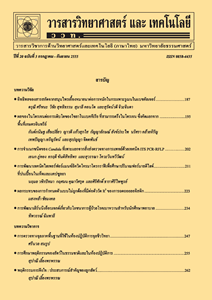Factors Affecting Amylose Analysis in Rice Samples by Iodine Binding Method
Main Article Content
Abstract
Factors affecting the error of amylose analysis in rice samples by iodine binding method were studied in order to establish a standard amylose analysis in rice samples for laboratories in Thailand. A comparison between an international standard method, ISO 6647: 2015 and rice department standard method, TAS 4004-2017 from the Ministry of Agriculture and Cooperatives (Thailand) was studied. The results showed that the main factor that caused large error in amylose analysis was the use of pure amylose standards instead of cultivated rice flour standards in constructing the calibration curve. The calibration curve constructed with cultivated rice flour standards was linearly followed the equation y = 0.0161x - 0.0046 with R2 0.9980. The precision within-day was 2.6 and 1.7 %RSD (n = 5) at amylose 12 and 29 %, respectively. The precision between-day was 5.3 and 3.1 %RSD (n = 10) at amylose 12 and 29 %, respectively. The accuracy of the method was validated with rice flour certified reference material BCR-467. The Student’s t-test showed that there was no significant difference in the result at 95 % confidence level. This method was used to analyze amylose in 26 rice samples with various cultivars.
Article Details
References
Tester, R.F., Karkalas, J., and Qi, X., 2004, Starch-composition, fine structure and architecture, J. Cereal Sci. 39: 151-165.
Suwannaporn, P., Pitiphunpong, S. and Champangern, S., 2007, Classification of rice amylose content by discriminant analysis of physicochemical properties, Starch Stärke 59: 171-177.
McCready, R.M. and Hassid, W.Z., 1943, The separation and quantitative estimation of amylose and amylopectin in potato starch, J. Am. Chem. Soc. 65: 1154-1157.
Juliano, B.O., 1971, A simplified assay for milled rice amylose, Cerel Sci. Today 16: 334-340.
International Organization for Standardiza tion (ISO), 2015, International Standard ISO/IEC 6647-1: 2015(E)-Rice-Determina tion of Amylose Content, Part 1: Reference Method, 2nd Ed., Geneva.
International Organization for Standardiza tion (ISO), 2015, International Standard ISO/IEC 6647-1: 2015(E)-Rice-Determina tion of Amylose Content, Part 2: Routine Method, 2nd Ed., Geneva.
Fitzgerald, M.A., Bergman, C.J., Resurrec cion, A.P., Möller, J., Jimenez, R., Reinke, R.F., Martin, M., Blanco, P., Molina, F., Chen, M.H., Kuri, V., Romero, M.V., Habibi, F., Umemoto, T., Jongdee, S., Graterol, E., Reddy, K.R., Bassinello, P.Z., Sivakami, R., Rani, N.S., Das, S., Wang, Y.J., Indrasari, S.D., Ramli, A., Ahmad, R., Dipti, S.S., Xie, L., Lang, N.T., Singh, P., Toro, D.C., Tavasoli, F. and Mestres, C., 2009, Addressing the dilemmas of measuring amylose in rice, Cereal Chem. 86: 492-498.
Ministry of Agriculture and Cooperatives, 2017, TAS 4004-2017: Thai Agricultural Standard: Thai Rice, National Bureau of Agricultural Commodity and Food Standards, Bangkok. (in Thai)
Rattanapol, P. and Sreewongchai, T., 2012, Development of amylose content analysis in rice grain using small amount of sample, 50th Kasetsart University Annual Conference: Agricultural Extension and Home Economics, Plants, Kasetsart University, Bangkok. (in Thai)
Juliano, B., Perez, C.M., Blakeney, A.B., Castillo, T., Kongseree, N., Laignelet, B. and Webb, B.D., 1981, International cooperative testing on the amylose content of milled rice, Starch Stärke 33: 157-162.
Avaro, M.R.A., Pan, Z., Yoshida, T. and Wada, Y., 2011, Two alternative methods to predict amylose content of rice grain by using tristimulus cie lab values and developing a specific color board of starch-iodine complex solution, Plant Prod. Sci. 14: 164-168.
Hu, X., Lu, L., Fang, C., Duan, B. and Zhu, Z., 2015, Determination of apparent amylose content in rice by using paper-based microfluidic chips, J. Agric. Food Chem. 63: 9863-9868.


